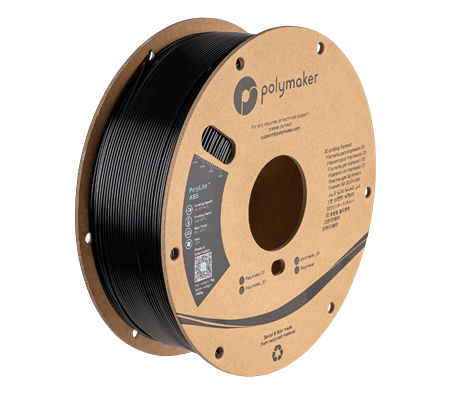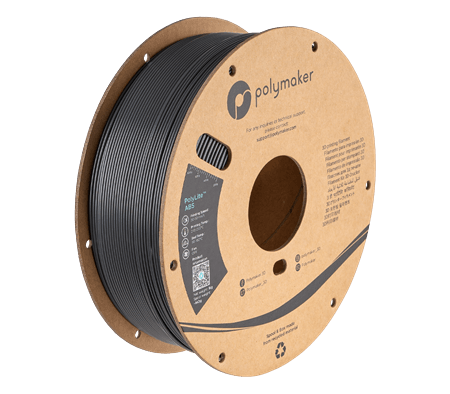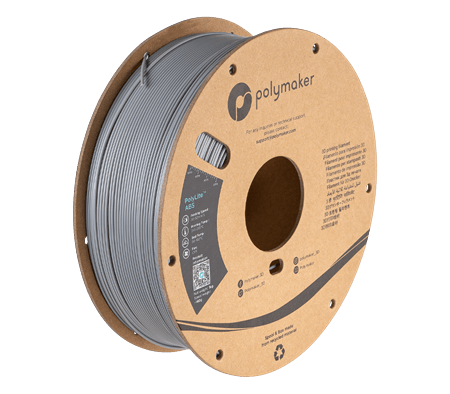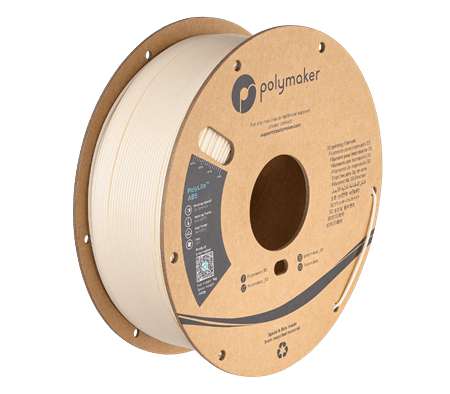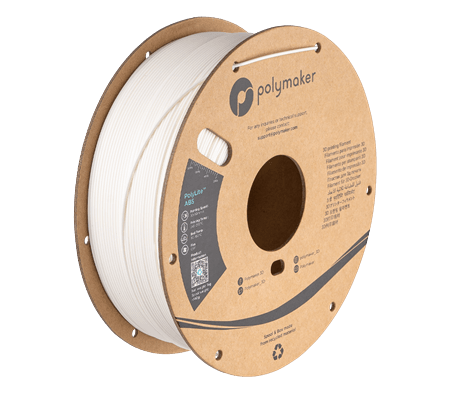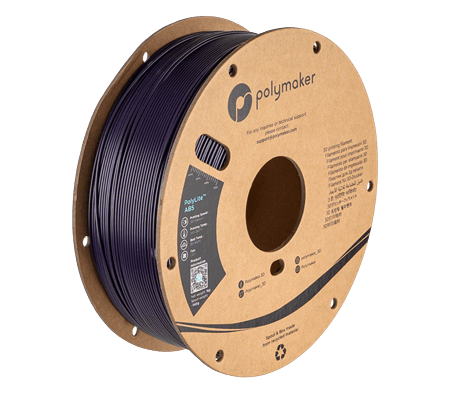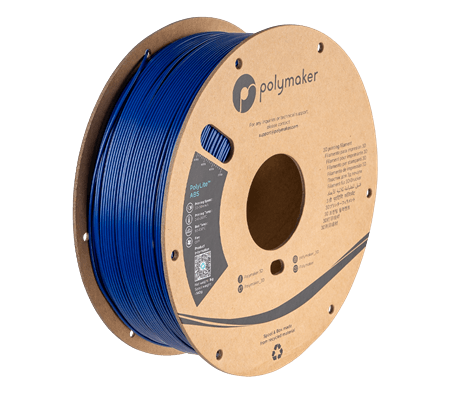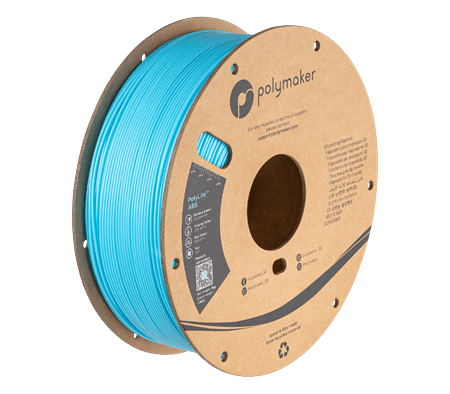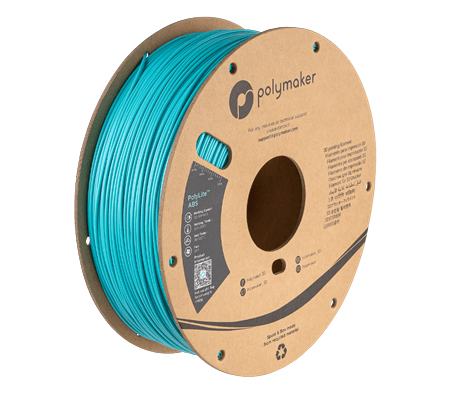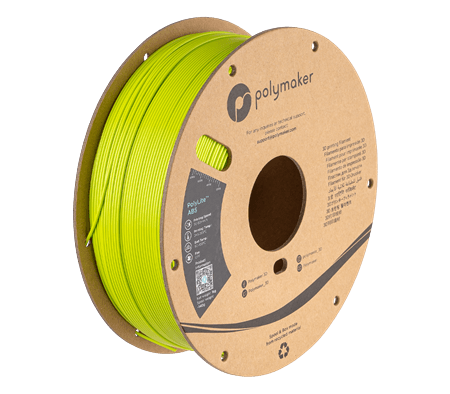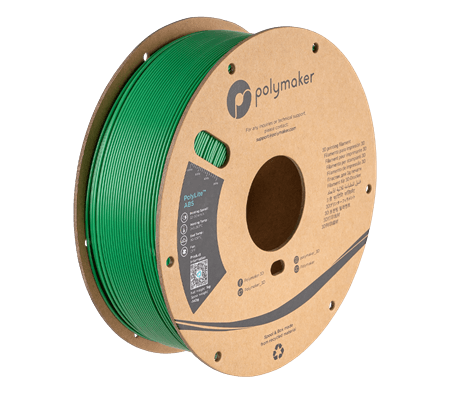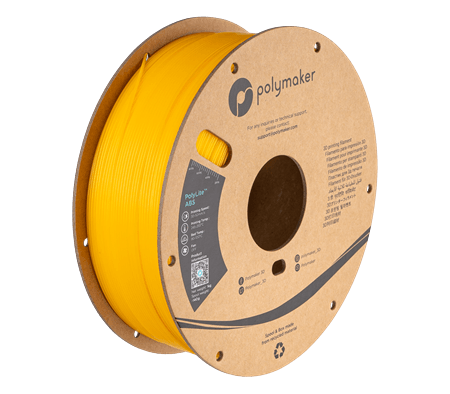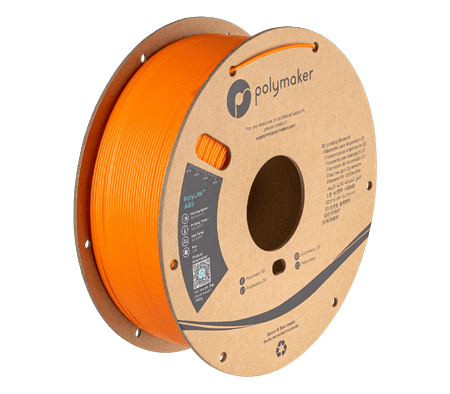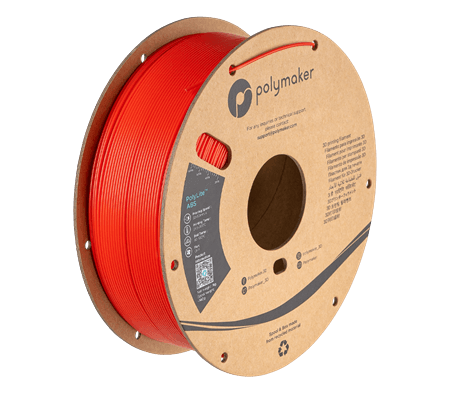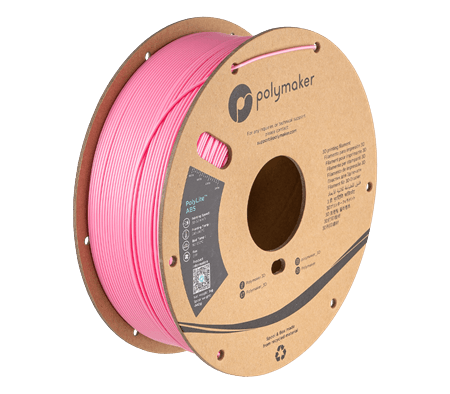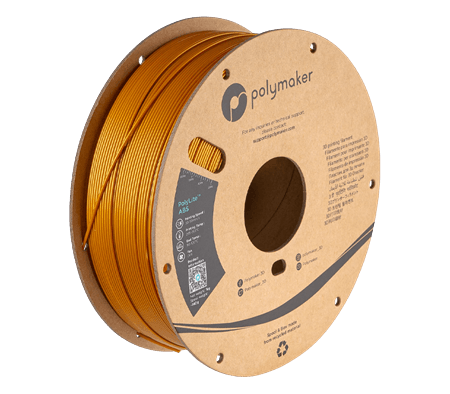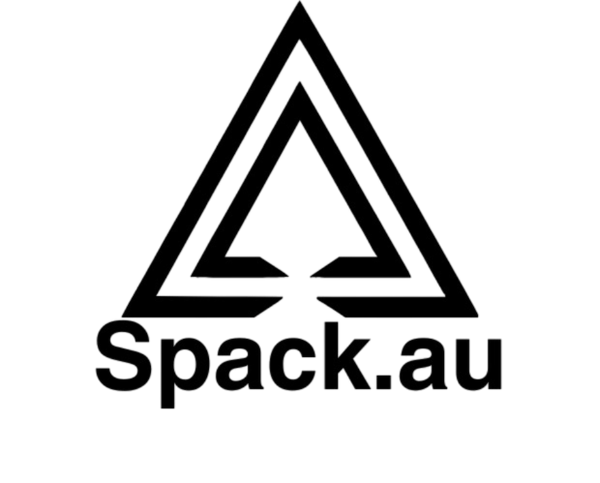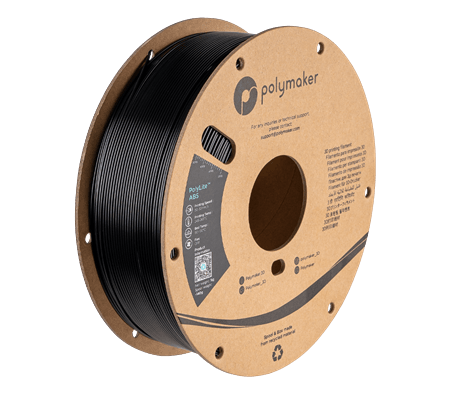Polymaker
Polymaker PolyLite ABS 1kg 1.75mm Filament
Polymaker PolyLite ABS 1kg 1.75mm Filament
Out of stock
Couldn't load pickup availability
High quality PolyLite™ ABS which has significantly lower volatile content compared to traditional ABS filaments.
- High quality Polymaker ABS with less odour.
- Great mechanical strength and durability.
- High heat resistance up to 99℃ HDT.
- Good post-processing capability.
- Consistent colour and tolerance (1.75mm diameter +/- 0.03mm)

PolyLite™ is a family of 3D printing filaments made with the best raw materials to deliver exceptional quality and reliability. PolyLite™ covers the most popular 3D printing materials to meet your everyday needs in design and prototyping. PolyLite™ ABS is made with a specialty bulk-polymerised ABS resin, which has significantly lower volatile content compared to traditional ABS resins. It delivers excellent printing quality with minimal odour during printing.
Features
- Less Odour - PolyLite™ ABS is made with a specialty bulk-polymerised ABS resin, which has significantly lower volatile content compared to traditional ABS resins. It delivers excellent printing quality for printing functional parts with minimal and reduced odour during printing.
- Balanced Mechanical / Thermal Properties - Many other brands of ABS filament feature additives which can reduce the heat resistance of the filament. PolyLite™ ABS is a "true" ABS filament, featuring well balanced mechanical and thermal properties, outperforming regular PLA and PETG in toughness while featuring a heat resistance up to 100°C.
- Excellent Printing Quality - PolyLite™ ABS is capable of printing high quality models and prototypes and is commonly used for 3D printing production parts. Made with only the highest quality materials, PolyLite™ ABS delivers excellent printing quality and reliability. Minimum 90°C heated bed required.
- Uncompromised Quality - With Polymaker's industry leading quality control process and rigorous in-house testing, you can rest assured that PolyLite™ ABS will produce beautiful, reliable and accurate printed parts.
Printing Settings
| Nozzle Temperature | 245°C - 265°C |
|---|---|
| Build Plate Temperature | 90°C - 100°C |
| Build Surface Material | Works well with most build surfaces i.e Glass, BuildTak® etc Rigid build plates recommended compared to magnetic flex plates. |
| Build Surface Treatment | Apply Magigoo Original or PVA glue to the build surface to improve adhesion. |
| Enclosure | Recommended. |
| Heated Chamber | Recommended for some geometries. 70˚C+ required for higher density and larger geometries. |
| Cooling Fan | LOW for better surface quality OFF for better strength |
| Printing Speed | 30 mm/s - 50 mm/s |
| Retraction | The ideal retraction settings vary from printer to printer and depend on the hot end. The following settings have been a good starting point for many machines. Direct Drive: Retraction distance of 1mm with retraction speed of 20mm/s Bowden: Retraction distance of 3mm with retraction speed of 40mm/s |
| Recommended Support Material |
Self-support. |
The above are printing recommendations based on 0.4 mm nozzle. Please note ideal printing conditions may vary depending on your 3D printer setup. For high speed 3D printers, make sure to increase your extrusion temperature in order to use higher printing speeds.
ABS filaments benefit from a hot environment. When printing larger or higher density models it can be beneficial to pre-heat your build plate 20 - 30 minutes before printing. In colder climates a longer pre-heating time may be useful.
For other tips printing PolyLite™ ABS contact us!
Specification
| Net Weight | 1kg |
|---|---|
| Material Type | ABS |
| Density | 1.12 (g/cm3 at 21.5˚C) |
| Colour |
Black |
Compatibility
PolyLite™ ABS has been engineered with compatibility in mind to print excellently on a wide range of professional 3D printers. This material requires a heated bed and we recommend printing with an enclosure or heated chamber for sizeable or thin models.
Of course with thousands of unique 3d printer models on the market, we can't guarantee each filament type will work with every 3D printer. Slicer experience and setting adjustment is always required to get the most out of a material. Before jumping into an ambitious project we always recommend printing some known calibration tests to build or make adjustments to the filament profile.
Technical Data
All testing specimens were printed under the following conditions: Nozzle Temperature = 260˚C, build plate temperature = 110˚C, infil = 100%, cooling fan = OFF
All specimens were conditioned at room temperature for 24h prior to testing.
THERMAL PROPERTIES
| Value | Testing Method | |
| Glass Transition | 101.1°C | DSC, 10°C/min |
| Heat Deflection Temperature |
0.45MPa - 99.6°C HDT Curve |
ISO 75 |
| Vicat Softening Temperature | 103.9°C | ISO 306, GB/T 1633 |
MECHANICAL PROPERTIES
| Value | Testing Method | |
| Youngs Modulus (X-Y) |
2,246.6 MPa | ISO 527, GB/T 1040 |
| Tensile Strength (X-Y) |
33.4 MPa | ISO 527, GB/T 1040 |
| Tensile Strength (Z) | 29.7 MPa | ISO 527, GB/T 1040 |
| Elongation at break (X-Y) | 17.9% | ISO 527, GB/T 1040 |
| Bending Modulus (X-Y) | 2,127.2 MPa | ISO 178, GB/T 9341 |
| Bending Strength (X-Y) |
56.2 ± 0.3 MPa | ISO 178, GB/T 9341 |
| Charpy Impact Strength (X-Y) |
18.0 ± 0.9 kJ/m2 | ISO 179, GB/T 1043 |
We have full MDS and technical data sheets for PolyLite™ ABS and all other Polymaker products. Contact us to enquire!
The typical values presented in Polymakers data sheet are intended for reference and comparison purposes only. Due to the nature of 3D printing they should not be used for design specifications or quality control purposes.
STORAGE & DRYING
All plastics are hygroscopic meaning they absorb moisture from the air which can affect printing quality and strength of printed parts. How quickly this absorption occurs depends on the material and your environment. PolyLite™ ABS filaments are dried and packaged in a vacuum sealed bag with desiccant to ensure the best printing quality. When not in use PolyLite™ ABS should be stored away from sunlight and sealed in the packaged resealable bag.
Although filaments can be dried, drying will speed up the aging process of the plastic. Preventing the filament from absorbing moisture in the first place is the best solution to keep your filament working to its maximum potential. For long term storage we highly recommend storing in a sealed container with dry desiccant that reduces the relative humidity to 10-20% RH.
In-house we manage our filaments with Polymakers PolyDryer™ which keep offers best-in-class sealing to protect filaments from absorbing moisture
If you hear popping sounds and notice that the surface quality of your print is uneven or the colour is not consistent, this is a likely indicator that the filament has absorbed too much moisture. Spools of PolyLite™ ABS can be dried with Polymaker PolyDryer™ using power level 2. Alternatively if you have a convection oven that is accurate at low temperatures, users can dry filament in a preheated convection oven at 70˚C for up to 6 hours. Results may vary depending on the accuracy of your oven so please be conservative. For more information about filament drying please read our user guide.
FAQ
Q: How does PolyLite™ ABS compare to other ABS materials?
A: Like Polymaker's other products, PolyLite™ ABS is designed specifically with 3D printing in mind. The raw ingredients in this material were chosen to reduce odor when printing and to maximise performance. Additionally users will also note when comparing technical data; PolyLite™ ABS is one of the strongest ABS materials on the market, outperforming many other brands.
Q: Do I need an enclosure to print PolyLite™ ABS?
A: This is really dependent on the ambient room temperature, size, geometry and infil density of your parts. The general rule of thumb is that the larger your project is, the more important an enclosure or heated chamber becomes. When printing without an enclosure it is important to keep the printer away from cold drafts that could impact the print.
Q: Can I post-process PolyLite™ ABS with acetone?
A: In short, yes PolyLite™ ABS can be smoothed with acetone although we highly recommend considering safer alternatives.
WARNING: Acetone is a dangerous chemical that requires handling with the necessary safety precautions. It is not a process we recommend and there are many methods which can pose a undue and serious fire risk which can cause damage to your health, property and even result in death. See Exhibit 1 - "reddit.com - TIFU by almost burning my house down trying to smooth out a 3D print"
Q: Is ABS a UV resistant plastic?
A: No, there are some misconceptions but ABS is not an inherently UV resistant plastic. A high quality ASA filament like PolyLite™ ASA is better suited for applications for the out doors. Alternatively some users paint their ABS 3D printed parts to provide UV protection.
Q: Can ABS be printed at large scales without warping?
A: A stable high temperature environment is required to print larger ABS parts without warping. Whether a part is susceptible to warping will vary on how the residual stress releases within the parts geometry. Most users print ABS with the heated bed set to 100˚C with an enclosure to passively heat the surrounding environment. This effectively reduces the internal stresses cause warping or cracking. To guarantee that ABS can be printed at any size without warping, 3D printing with a professionally designed heated chamber is required.
Q: Should I rewind this filament if I want to use it with a different spool?
A: We strongly advise against tampering with the product by rewinding. See our article for full details about the risks. All Polymaker filaments are wound with tension but without strain. Rewinding completely rearranges the curvature of the winding and this strain over time can cause most plastics to catastrophically break. If for some reason your printer is locked into fitting less than standard sized spools, there may be safe printable adaptors or external mounting solutions available.
Don't know where to start? Or which filament will suit your application? We have a broad range of support options including telephone support. Contact us today!
| Filament | |
| Diameter | 1.75mm |
| Spool Weight | 1kg |
ABS is one of the earliest and most common 3D Printing materials which has maintained its popularity for prototyping and additive manufacturing applications due to its low cost, balanced mechanical / thermal properties and excellent printing quality.
- Great toughness and heat resistance.
- Excellent price when compared to other engineering plastics.
- ABS materials are relatively easy to sand.
While printing with the right environmental temperature is very important for this material, ABS is an incredibly popular and worthwhile choice for low cost and functional applications.

PolyLite™ ABS is a cost effective material for manufacturing functional parts with great toughness, chemical resistance, heat resistance and ductility. With a heat resistance of up to 100˚C, PolyLite™ ABS can handle the temperature requirements of a wide range of applications, offering a durable solution for product manufacturing. When compared to materials like regular PLA and PETG, PolyLite™ ABS features improved ductility, enabling users to print parts designed with snap fit componentry.
Materials
Materials
PLA - This solid filament is used to make models that are a refined representation with rigid properties.
TPU - This flexible filament holds the shape of the model and can with stand being twisted and squashed to survive the field environment.
Shipping
Shipping
Free standard shipping and Express for free orders over $300 calculated at the checkout.
All items are shipped from Townsville, QLD.
Shipping World Wide - coming soon.
Care Instructions
Care Instructions
PLA
Temperature:
Keep it cool! PLA starts to soften at around 60°C (140°F), so avoid placing it near heat sources or leaving it in hot cars.
Sunlight:
Prolonged direct sunlight can cause fading and potential deformation. Try to keep it out of long sun exposures.
Cleaning:
Gently wash with warm water and a bit of mild soap using a soft cloth. No harsh scrubbing, please!
Handling:
Handle with care—avoid excessive bending or dropping it, as PLA is rigid and can crack or break.
Storage:
Store in a cool, dry place to maintain its shape and longevity.
TPU
Temperature:
TPU is built to be flexible, but still avoid extreme or prolonged heat. It’s more resilient than PLA, but unnecessary heat can still degrade it over time.
Sunlight:
Try not to leave TPU items in direct sunlight for too long, as UV rays can fade the colors and slowly affect the material quality.
Cleaning:
Just like PLA, a quick clean with warm water and mild soap works great. Use a soft cloth and don’t be too rough.
Handling:
Enjoy its flexibility! However, even though TPU can bend, continuous stretching or heavy impacts might wear it out faster.
Storage:
Keep it in a cool, dry spot away from harsh elements to maintain its flexibility and appearance.
Share
